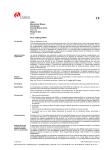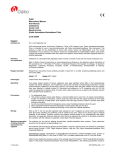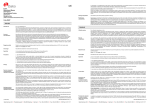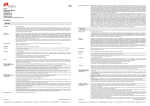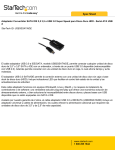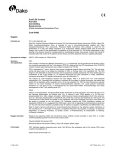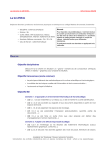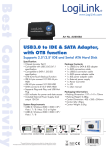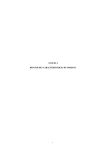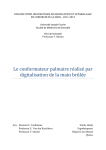Download (Dako Autostainer/Autostainer Plus) Code IS611
Transcript
staining pattern is identical to the staining pattern described in “Performance characteristics”. Counterstaining in hematoxylin is recommended using EnVision FLEX Hematoxylin, (Dako Autostainer/Autostainer Plus) (Code K8018). Nonaqueous, permanent mounting medium is recommended. Positive and negative controls should be run simultaneously using the same protocol as the patient specimens. The positive control tissue should include colon and tonsil and the cells/structures should display reaction patterns as described for these tissues in “Performance characteristics” in all positive specimens. The recommended negative control reagent is FLEX Negative Control, Mouse, (Dako Autostainer/Autostainer Plus) (Code IS750). FLEX Monoclonal Mouse Anti-Human Smooth Muscle Actin Clone 1A4 Ready-to-Use (Dako Autostainer/Autostainer Plus) Staining interpretation Cells labeled by the antibody display cytoplasmic staining. Performance characteristics Normal tissues: The antibody labels smooth muscle cells in blood vessels and, additionally, salivary ducts and myoepithelial cells around acini in salivary glands (2). Smooth muscle cells in 35/36 normal uterine myometria were also positively labeled (1). Further, a temporal labeling of perisinusoidal liver cells has been observed (6). Smooth muscle cells in the lamina muscularis mucosa of colon show a moderate to strong staining reaction, whereas smooth muscle cells lining the liver sinusoids show a weak to moderate staining reaction. Abnormal tissues: The antibody labels 24/26 leiomyomas, 6/7 atypical leiomyomas and 21/25 leiomyosarcomas of the uterus, as well as 13/13 extrauterine nongastrointestinal spindled leiomyosarcomas (1). Moreover, the antibody labels a variable amount of cells in 8/8 pseudosarcomatous myofibroblastic tumors of the urinary bladder in children (7). In pleomorphic adenomas, the antibody labeled tumor epithelial cells (myoepithelial cells) in 19/20 cases (2). Code IS611 ENGLISH Intended use For in vitro diagnostic use. FLEX Monoclonal Mouse Anti-Human Smooth Muscle Actin, Clone 1A4, Ready-to-Use, (Dako Autostainer/Autostainer Plus), is intended for use in immunohistochemistry together with Dako Autostainer/Autostainer Plus instruments. This antibody labels smooth muscle cells, myofibroblasts and myoepithelial cells, and is useful for the identification of leiomyomas, leiomyosarcomas (1), and pleomorphic adenomas (2). Differential identification is aided by the results from a panel of antibodies. The clinical interpretation of any staining or its absence should be complemented by morphological studies using proper controls and should be evaluated within the context of the patient's clinical history and other diagnostic tests by a qualified pathologist. Summary and explanation Cytoplasmic actins, which belong to the microfilament system of cytoskeleton proteins, are some of the most conserved eukaryotic proteins being expressed in mammals and birds. The actin protein consists of six isoforms, varying in their amino acid sequence, but all having the same molecular mass of 42 kDa. The isoforms show more than 90% overall sequence homology, but only 50-60% homology in their 18 Nterminal residues. The N-terminal region appears to be a major antigenic region (3). There are different α isoforms specific for muscle tissues, i.e. skeletal muscle α, cardiac muscle α, and smooth muscle α, respectively (4). The β- and γ-actins may be present in muscle cells as well as most other cell types in the body, including non-muscle cells (5). Refer to Dako’s General Instructions for Immunohistochemical Staining or the detection system instructions of IHC procedures for: 1) Principle of Procedure, 2) Materials Required, Not Supplied, 3) Storage, 4) Specimen Preparation, 5) Staining Procedure, 6) Quality Control, 7) Troubleshooting, 8) Interpretation of Staining, 9) General Limitations. Reagent provided Ready-to-use monoclonal mouse antibody provided in liquid form in a buffer containing stabilizing protein and 0.015 mol/L sodium azide. Clone: 1A4. The 1A4 clone is identical to the anti-asm-1 described in (3). Isotype: IgG2a, kappa. Immunogen N-terminal synthetic decapeptide of α-smooth muscle actin coupled to keyhole limpet haemocyanin (KLH) (4). Specificity In Western blotting and SDS-PAGE immunoblotting of the α-smooth muscle isoform of actin, the antibody labels a band corresponding to αsmooth muscle actin (3). FRANÇAIS Utilisation prévue Pour utilisation diagnostique in vitro. FLEX Monoclonal Mouse Anti-Human Smooth Muscle Actin, clone 1A4, Ready-to-Use, (Dako Autostainer/Autostainer Plus), est destiné à une utilisation en immunocytochimie avec les instruments Dako Autostainer/Autostainer Plus. Cet anticorps marque les cellules du muscle lisse, les myofibroblastes et les cellules myoépithéliales. C’est un outil utile pour l’identification des léiomyomes, des léiomyosarcomes (1) et des adénomes pléomorphes (2). L’identification différentielle est facilitée par les résultats provenant d’un panel d’anticorps. L’interprétation clinique de toute coloration ou son absence doit être complétée par des études morphologiques en utilisant des contrôles appropriés et doit être évaluée en fonction des antécédents cliniques du patient et d’autres tests diagnostiques par un pathologiste qualifié. Résumé et explication Les actines cytoplasmiques, appartenant au système de microfilaments des protéines du cytosquelette, font partie des protéines eucaryotes les plus conservées, exprimées chez les mammifères et les oiseaux. La protéine d’actine comprend six isoformes, variant par leur séquence en acides aminés, mais ayant toutes le même poids moléculaire de 42 kDa. Les isoformes ont plus de 90 % d’homologie de séquence au total mais seulement 50 à 60 % d’homologie entre leurs 18 groupements N-terminaux. La région N-terminale semble être une région antigénique très importante (3). Il existe différents isoformes α spécifiques pour les tissus musculaires c’est-à-dire l’isoforme α du muscle squelettique, l’isoforme α du muscle cardiaque et l’isoforme α du muscle lisse, respectivement (4). Les β- et γ-actines peuvent être présentes dans les cellules musculaires, ainsi que dans la plupart des autres types de cellules de l’organisme, y compris les cellules non musculaires (5). Se référer aux Instructions générales de coloration immunohistochimique de Dako ou aux instructions du système de détection relatives aux procédures IHC pour plus d’informations concernant les points suivants : 1) Principe de procédure, 2) Matériels requis mais non fournis, 3) Conservation, 4) Préparation des échantillons, 5) Procédure de coloration, 6) Contrôle qualité, 7) Dépannage, 8) Interprétation de la coloration, 9) Limites générales. Réactifs fournis Anticorps monoclonal de souris prêt à l’emploi fourni sous forme liquide dans un tampon contenant une protéine stabilisante et 0,015 mol/L d’azide de sodium. Clone : 1A4. Le clone 1A4 est identique à l’anticorps anti-asm-1 décrit à la référence (3). Isotype : IgG2a, kappa. Immunogène Décapeptide synthétique de la séquence N-terminale de l’α-actine du muscle lisse couplé à de l’hémocyanine de patelle (keyhole limpet haemocyanin, KLH) (4). Spécificité Dans les analyses par Western blot et par immunoblot SDS-PAGE de l’isoforme α-actine du muscle lisse, l’anticorps marque une bande correspondant à l’α-actine du muscle lisse (3). Comme le démontrent le Western blot et/ou l’immunocytochimie, l’anticorps présente une réaction croisée à la protéine homologue à l’α−actine du muscle lisse chez le poulet, la vache et le rat (3). Précautions 1. Pour utilisateurs professionnels. 2. Ce produit contient de l’azide de sodium (NaN3), produit chimique hautement toxique dans sa forme pure. Aux concentrations du produit, bien que non classé comme dangereux, l’azide de sodium peut réagir avec le cuivre et le plomb des canalisations et former des accumulations d’azides métalliques hautement explosifs. Lors de l’élimination, rincer abondamment à l’eau pour éviter toute accumulation d’azide métallique dans les canalisations. 3. Comme avec tout produit d’origine biologique, des procédures de manipulation appropriées doivent être respectées. 4. Porter un vêtement de protection approprié pour éviter le contact avec les yeux et la peau. 5. Les solutions non utilisées doivent être éliminées conformément aux réglementations locales et nationales. Conservation Conserver entre 2 et 8 °C. Ne pas utiliser après la date de péremption indiquée sur le flacon. Si les réactifs sont conservés dans des conditions autres que celles indiquées, celles-ci doivent être validées par l’utilisateur. Il n’y a aucun signe évident indiquant l’instabilité de ce produit. Par conséquent, des contrôles positifs et négatifs doivent être testés en même temps que les échantillons de patient. Si une coloration inattendue est observée, qui ne peut être expliquée par un changement des procédures du laboratoire, et en cas de suspicion d’un problème lié à l’anticorps, contacter l’assistance technique de Dako. Préparation des échantillons y compris le matériel requis mais non fourni L’anticorps peut être utilisé pour le marquage des coupes de tissus inclus en paraffine et fixés au formol. L’épaisseur des coupes d’échantillons de tissu doit être d’environ 4 µm. Un prétraitement avec démasquage d’épitope induit par la chaleur (HIER) est nécessaire avec le Dako PT Link (Réf. PT100/PT101). Pour plus de détails, se référer au Guide d’utilisation du PT Link. Des résultats optimaux sont obtenus en prétraitant les tissus à l’aide de la EnVision FLEX Target Retrieval Solution, High pH (50x) (Réf. K8010/K8004). Coupes incluses en paraffine : le prétraitement des coupes tissulaires fixées au formol et incluses en paraffine est recommandé à l'aide de la procédure de préparation d'échantillon 3-en-un pour le Dako PT Link. Suivre la procédure de prétraitement indiquée dans la notice de la EnVision FLEX Target Retrieval Solution, High pH (50x) (Réf. K8010/K8004). Remarque : après coloration, les coupes doivent être déshydratées, lavées et montées à l’aide d’un milieu de montage permanent. Coupes déparaffinées : le prétraitement des coupes tissulaires déparaffinées, fixées au formol et incluses en paraffine, est recommandé à l’aide du Dako PT Link, en suivant la même procédure que pour les coupes incluses en paraffine. Après coloration, un montage aqueux ou permanent des lames est recommandé. Les coupes de tissus ne doivent pas sécher lors du traitement ni lors de la procédure de coloration immunohistochimique suivante. Pour une meilleure adhérence des coupes de tissus sur les lames de verre, il est recommandé d’utiliser des lames FLEX IHC Microscope Slides (Réf. K8020). As demonstrated by Western blotting and/or immunocytochemistry, the antibody cross-reacts with the α-smooth muscle actin-equivalent protein in chicken, cow and rat (3). Precautions 1. For professional users. 2. This product contains sodium azide (NaN3), a chemical highly toxic in pure form. At product concentrations, though not classified as hazardous, sodium azide may react with lead and copper plumbing to form highly explosive build-ups of metal azides. Upon disposal, flush with large volumes of water to prevent metal azide build-up in plumbing. 3. As with any product derived from biological sources, proper handling procedures should be used. 4. Wear appropriate Personal Protective Equipment to avoid contact with eyes and skin. 5. Unused solution should be disposed of according to local, State and Federal regulations. Storage Store at 2-8 °C. Do not use after expiration date sta mped on vial. If reagents are stored under any conditions other than those specified, the conditions must be verified by the user. There are no obvious signs to indicate instability of this product. Therefore, positive and negative controls should be run simultaneously with patient specimens. If unexpected staining is observed which cannot be explained by variations in laboratory procedures and a problem with the antibody is suspected, contact Dako Technical Support. Specimen preparation including materials required but not supplied The antibody can be used for labeling formalin-fixed, paraffin-embedded tissue sections. Tissue specimens should be cut into sections of approximately 4 µm. Pre-treatment with heat-induced epitope retrieval (HIER) is required using Dako PT Link (Code PT100/PT101). For details, please refer to the PT Link User Guide. Optimal results are obtained by pretreating tissues using EnVision FLEX Target Retrieval Solution, High pH (50x) (Code K8010/K8004). Paraffin-embedded sections: Pre-treatment of formalin-fixed, paraffin-embedded tissue sections is recommended using the 3-in-1 specimen preparation procedure for Dako PT Link. Follow the pre-treatment procedure outlined in the package insert for EnVision FLEX Target Retrieval Solution, High pH (50x) (Code K8010/K8004). Note: After staining the sections must be dehydrated, cleared and mounted using permanent mounting medium. Deparaffinized sections: Pre-treatment of deparaffinized formalin-fixed, paraffin-embedded tissue sections is recommended using Dako PT Link and following the same procedure as described for paraffin-embedded sections. After staining the slides should be mounted using aqueous or permanent mounting medium. The tissue sections should not dry out during the treatment or during the following immunohistochemical staining procedure. For greater adherence of tissue sections to glass slides, the use of FLEX IHC Microscope Slides (Code K8020) is recommended. Staining procedure including materials required but not supplied The recommended visualization system is EnVision FLEX, High pH, (Dako Autostainer/Autostainer Plus) (Code K8010). The staining steps and incubation times are pre-programmed into the software of Dako Autostainer/Autostainer Plus instruments, using the following protocols: Template protocol: FLEXRTU2 (200 µL dispense volume) or FLEXRTU3 (300 µL dispense volume)Autoprogram: SMActin (without counterstaining) or SMActinH (with counterstaining). The Auxiliary step should be set to “rinse buffer” in staining runs with ≤10 slides. For staining runs with >10 slides the Auxiliary step should be set to “none”. This ascertains comparable wash times. All incubation steps should be performed at room temperature. For details, please refer to the Operator’s Manual for the dedicated instrument. If the protocols are not available on the used Dako Autostainer instrument, please contact Dako Technical Services. Optimal conditions may vary depending on specimen and preparation methods, and should be determined by each individual laboratory. If the evaluating pathologist should desire a different staining intensity, a Dako Application Specialist/Technical Service Specialist can be contacted for information on re-programming of the protocol. Verify that the performance of the adjusted protocol is still valid by evaluating that the (115187-002) Dako Denmark A/S IS611/EFG/MNI/2009.12.04 p. 1/4 | Produktionsvej 42 | DK-2600 Glostrup | Denmark | Tel. +45 44 85 95 00 | Fax +45 44 85 95 95 | CVR No. 33 21 13 17 (115187-002) Dako Denmark A/S IS611/EFG/MNI/2009.12.04 p. 2/4 | Produktionsvej 42 | DK-2600 Glostrup | Denmark | Tel. +45 44 85 95 00 | Fax +45 44 85 95 95 | CVR No. 33 21 13 17 Procédure de coloration y compris le matériel requis mais non fourni Le système de visualisation recommandé est le EnVision FLEX, High pH, (Dako Autostainer/Autostainer Plus) (Réf. K8010). Les étapes de coloration et d’incubation sont préprogrammées dans le logiciel des instruments Dako Autostainer/Autostainer Plus, à l’aide des protocoles suivants : Protocole modèle : FLEXRTU2 (volume de distribution de 200 µL) ou FLEXRTU3 (volume de distribution de 300 µL) Autoprogram : SMActin (sans contre-coloration) ou SMActinH (avec contre-coloration). Vorbereitung der Probe und erforderliche, aber nicht mitgelieferte Materialien Der Antikörper eignet sich zur Markierung von formalinfixierten und paraffineingebetteten Gewebeschnitten. Gewebeproben sollten in Schnitte von ca. 4 µm Stärke geschnitten werden. Die Vorbehandlung durch hitzeinduzierte Epitopdemaskierung (HIER) mit Dako PT Link (Code-Nr. PT100/PT101) ist erforderlich. Weitere Informationen hierzu siehe PT Link-Benutzerhandbuch. Optimale Ergebnisse können durch Vorbehandlung der Gewebe mit EnVision FLEX Target Retrieval Solution, High pH (50x) (Code-Nr. K8010/K8004) erzielt werden. Paraffineingebettete Schnitte: Die Vorbehandlung der formalinfixierten, paraffineingebetteten Schnitte mit dem 3-in-1Probenvorbereitungsverfahren für Dako PT Link wird empfohlen. Vorbehandlung gemäß der Beschreibung in der Packungsbeilage für EnVision FLEX Target Retrieval Solution, High pH (50x) (Code-Nr. K8010/K8004) durchführen. Hinweis: Nach dem Färben müssen die Schnitte dehydriert, geklärt und mit permanentem Einbettmedium auf den Objektträger aufgebracht werden. Entparaffinierte Schnitte: Eine Vorbehandlung der entparaffinierten, formalinfixierten, paraffineingebetteten Gewebeschnitte mit Dako PT Link nach demselben Verfahren, wie für die paraffineingebetteten Schnitte beschrieben, wird empfohlen. Die Objektträger nach dem Färben mit einem wässrigen oder permanenten Einbettmedium bedecken. Die Gewebeschnitte dürfen während der Behandlung oder des anschließenden immunhistochemischen Färbeverfahrens nicht austrocknen. Zur besseren Haftung der Gewebeschnitte an den Glasobjektträgern wird die Verwendung von FLEX IHC Microscope Slides (Code-Nr. K8020) empfohlen. Färbeverfahren und erforderliche, aber nicht mitgelieferte Materialien Das empfohlene Visualisierungssystem ist EnVision™ FLEX+, High pH, (Dako Autostainer/Autostainer Plus) (Code-Nr. K8010). Die Färbeschritte und Inkubationszeiten sind in der Software der Dako Autostainer/Autostainer Plus-Geräte mit den folgenden Protokollen vorprogrammiert: Matrixprotokoll: FLEXRTU2 (200 µL Abgabevolumen) oder FLEXRTU3 (300 µL Abgabevolumen) Autoprogram: SMActin (ohne Gegenfärbung) oder SMActinH (mit Gegenfärbung) Bei Färbedurchläufen mit höchstens 10 Objektträgern sollte der „Zusatz“-Schritt auf „Pufferspülgang“ eingestellt werden. Für Färbedurchläufe mit mehr als 10 Objektträgern den „Zusatz“-Schritt auf „Keine“ einstellen. Dieses gewährleistet vergleichbare Waschzeiten. Alle Inkubationsschritte sollten bei Raumtemperatur durchgeführt werden. Nähere Einzelheiten bitte dem Benutzerhandbuch für das jeweilige Gerät entnehmen. Wenn die Färbeprotokolle auf dem verwendeten Dako Autostainer-Gerät nicht verfügbar sind, bitte den Technischen Kundendienst von Dako verständigen. Optimale Bedingungen können je nach Probe und Präparationsverfahren unterschiedlich sein und sollten vom jeweiligen Labor selbst ermittelt werden. Falls der beurteilende Pathologe eine andere Färbungsintensität wünscht, kann ein Anwendungsspezialist oder Kundendiensttechniker von Dako bei der Neuprogrammierung des Protokolls helfen. Die Leistung des angepassten Protokolls muss verifiziert werden, indem gewährleistet wird, dass das Färbemuster mit dem unter „Leistungsmerkmale“ beschriebenen Färbemuster identisch ist. Die Gegenfärbung in Hämatoxylin sollte mit EnVision™ FLEX Hematoxylin (Dako Autostainer/Autostainer Plus) (Code-Nr. K8018) ausgeführt werden. Empfohlen wird ein nichtwässriges, permanentes Fixiermittel. Positiv- und Negativkontrollen sollten zur gleichen Zeit und mit demselben Protokoll wie die Patientenproben getestet werden. Das positive Kontrollgewebe muss Zellen aus Dickdarm- und Mandelgewebe enthalten, und die Zellen/Strukturen müssen in allen positiven Proben die für dieses Gewebe unter „Leistungsmerkmale“ beschriebenen Reaktionsmuster aufweisen. Das empfohlene Negativ-Kontrollreagenz ist FLEX Negative Control, Mouse, (Dako Autostainer/Autostainer Plus) (Code-Nr. IS750). Auswertung der Färbung Mit diesem Antikörper markierte Zellen weisen ein zytoplasmatisches Färbemuster auf. Leistungsmerkmale Gesundes Gewebe: Der Antikörper markiert Glattmuskelzellen in Blutgefäßen und zusätzlich Speichelgänge und Myoepithelzellen um die Azini in Speicheldrüsen (2). Zellen der Glattmuskulatur bei 35 von 36 gesunden Uterusmyometrien wurden ebenfalls markiert (1). Ferner wurde eine temporäre Markierung von perisinusoidalen Leberzellen beobachtet (6). Zellen der Glattmuskulatur in der Lamina muscularis mucosa des Dickdarms weisen eine mäßige bis starke Färbereaktion auf, während die Zellen der Glattmuskulatur der Lebersinusoide eine schwache bis mäßige Färbereaktion aufweisen. L’étape Auxiliary doit être réglée sur « rinse buffer » lors des cycles de coloration avec ≤10 lames. Pour les cycles de coloration de >10 lames, l’étape Auxiliary doit être réglée sur « none ». Cela confirme des temps de lavage comparables. Toutes les étapes d’incubation doivent être effectuées à température ambiante. Pour plus de détails, se référer au Manuel de l’opérateur spécifique à l'instrument. Si les protocoles ne sont pas disponibles sur l’instrument Dako Autostainer utilisé, contacter le service technique de Dako. Les conditions optimales peuvent varier en fonction du prélèvement et des méthodes de préparation, et doivent être déterminées par chaque laboratoire individuellement. Si le pathologiste qui réalise l’évaluation désire une intensité de coloration différente, un spécialiste d’application/spécialiste du service technique de Dako peut être contacté pour obtenir des informations sur la re-programmation du protocole. Vérifier que l'exécution du protocole modifié est toujours valide en vérifiant que le schéma de coloration est identique au schéma de coloration décrit dans les « Caractéristiques de performance ». Il est recommandé d’effectuer une contre-coloration à l’aide d’hématoxyline EnVision FLEX Hematoxylin, (Dako Autostainer/Autostainer Plus) (Réf. K8018). L’utilisation d’un milieu de montage permanent non aqueux est recommandée. Des contrôles positifs et négatifs doivent être réalisés en même temps et avec le même protocole que les échantillons du patient. Le contrôle de tissu positif doit comprendre l’amygdale et le côlon et les cellules/structures doivent présenter des schémas de réaction tels que décrits pour ces tissus dans les « Caractéristiques de performance » pour tous les échantillons positifs. Le contrôle négatif recommandé est le FLEX Negative Control, Mouse, (Dako Autostainer/Autostainer Plus) (Réf. IS750). Interprétation de la coloration Les cellules marquées par l’anticorps présentent une coloration cytoplasmique. Caractéristiques de performance Tissus sains : L’anticorps marque les cellules musculaires lisses des vaisseaux sanguins et, également, les canaux salivaires et les cellules myoépithéliales entourant les acini dans les glandes salivaires (2). Les cellules de muscle lisse ont également été marquées positivement dans 35 cas sur 36 de myomètre utérin sain (1). De plus, un marquage temporel des cellules péri-sinusoïdes hépatiques a été observé (6). Les cellules du muscle lisse de la muqueuse lamina muscularis du côlon présentent une coloration modérée à forte, tandis que la coloration des cellules du muscle lisse qui tapissent les sinusoïdes du foie est faible à modérée. Tissus tumoraux : L’anticorps a marqué 24 cas sur 26 de léiomyomes, 6 cas sur 7 de léiomyomes atypiques et 21 cas sur 25 de léiomyosarcomes de l’utérus, ainsi que 13 cas sur 13 de léiomyosarcomes en fuseau extra-utérins non gastro-intestinaux (1). De plus, l’anticorps a marqué un taux variable de cellules dans 8 cas sur 8 de tumeurs myofibroblastiques pseudosarcomateuses de la vessie chez l’enfant (7). Dans les adénomes pléomorphes, l’anticorps a marqué les cellules épithéliales des tumeurs (cellules myoépithéliales) dans 19 cas sur 20 (2). DEUTSCH Verwendungszweck Zur In-vitro-Diagnostik. FLEX Monoclonal Mouse Anti-Human Smooth Muscle Actin, Clone 1A4, Ready-to-Use, (Dako Autostainer/Autostainer Plus) ist zur Verwendung in der Immunhistochemie in Verbindung mit Dako Autostainer/Autostainer Plus-Geräten bestimmt. Dieser Antikörper markiert Zellen der glatten Muskulatur, Myofibroblasten und Myoepithelzellen und dient zur Identifizierung von Leiomyomen, Leiomyosarkomen (1) und pleomorphen Adenomen (2). Die Differenzialdiagnose wird durch die Ergebnisse eines Antikörper-Panels unterstützt. Die klinische Auswertung einer eventuell eintretenden Färbung sollte durch morphologische Studien mit ordnungsgemäßen Kontrollen ergänzt werden und von einem qualifizierten Pathologen unter Berücksichtigung der Krankengeschichte und anderer Diagnostiktests des Patienten vorgenommen werden. Zusammenfassung und Erklärung Zytoplasmische Aktine, die dem Mikrofilamentsystem der Zytoskelettproteine angehören, befinden sich unter den meistkonservierten eukaryotischen Proteinen, die in Säugetieren und Vögeln exprimiert werden. Das Aktinprotein besteht aus sechs Isoformen mit unterschiedlicher Aminosäuresequenz, jedoch mit einem einheitlichen Molekulargewicht von 42 kDa. Die Sequenz der Isoformen ist zu mehr als 90 % homolog, die der 18 N-terminalen Reste jedoch nur zu 50–60 %. Der N-terminale Bereich ist anscheinend der wichtigste antigene Bereich (3). Es existieren verschiedene α−Isoformen die jeweils spezifisch für Muskelgewebe sind, wie z.B. Skelettmuskel-α, Herzmuskel-α, Glattmuskel-α (4). Die β- und γ-Aktine können in Muskelzellen und ebenso in den meisten anderen Zelltypen im Körper, einschließlich NichtMuskelzellen, auftreten (5). Folgende Angaben bitte den Allgemeinen Richtlinien zur immunhistochemischen Färbung von Dako oder den Anweisungen des Detektionssystems für IHC-Verfahren entnehmen: 1) Verfahrensprinzip, 2) Erforderliche, aber nicht mitgelieferte Materialien, 3) Aufbewahrung, 4) Vorbereitung der Probe, 5) Färbeverfahren, 6) Qualitätskontrolle, 7) Fehlersuche und -behebung, 8) Auswertung der Färbung, 9) Allgemeine Beschränkungen. Mitgelieferte Reagenzien Gebrauchsfertiger, monoklonaler Maus-Antikörper in flüssiger Form in einem Puffer, der stabilisierendes Protein und 0,015 mol/L Natriumazid enthält. Klon: 1A4. Das 1A4-Klon ist mit dem unter (3) beschriebenen Anti-ASM-1 identisch. Isotyp: IgG2a, Kappa. Immunogen An Napfschnecken-Hämocyanin gekoppeltes N-terminales synthetisches Dekapeptid von α-Glattmuskelaktin (4). Spezifität Beim Western-Blotting und SDS-PAGE-Immunblotting der α-Glattmuskel-Isoform von Aktin markiert der Antikörper eine Bande, die dem αGlattmuskel-Aktin entspricht (3). Pathologisches Gewebe: Der Antikörper markierte 24 von 26 Leiomyomen, 6 von 7 atypischen Leiomyomen und 21 von 25 Leiomyosarkomen des Uterus, sowie 13 von 13 extrauterinen, nicht-gastrointestinalen spindelzelligen Leiomyosarkomen (1). Außerdem markierte der Antikörper unterschiedliche Mengen von Zellen in 8 von 8 pseudosarkomatösen myofibroblastischen Tumoren der Harnblase bei Kindern (7). In pleomorphen Adenomen markierte der Antikörper Tumorepithelzellen (Myoepithelzellen) in 19 von 20 Fällen (2). References/ Références/ Literatur 1. Brennan PA, Umar T, Zaki GA, Langdon JD, Spedding A, Buckley J, et al. Are myoepithelial cells responsible for the widespread expression of inducible nitric oxide synthase in pleomorphic adenoma? An immunohistochemical study. J Oral Pathol Med 2000;29:279-83. 2. Skalli O, Ropraz P, Trzeciak A, Benzonana G, Gillessen D, Gabbian G. A monoclonal antibody against α-smooth muscle actin: a new probe for smooth muscle differentiation. J Cell Biol 1986; 103:2787-96. Alberts B, Bray D, Lewis J, Raff M, Roberts K, Watson JD. The cytoskeleton. In: Alberts B, Bray D, Lewis J, Raff M, Roberts K, Watson JD, editors. Molecular biology of the cell. 2nd ed. New York and London: Garland Publishing; 1989. p. 613-629. Rizeq MN, van de Rijn M, Hendrickson MR, Rouse RV. A comparative immunohistochemical study of uterine smooth muscle neoplasms with emphasis on the epithelioid variant. Hum Pathol 1994; 25:671-7. Schmitt-Gräff A, Krüger S, Bochard F, Gabbiani G, Denk H. Modulation of alpha smooth muscle actin and desmin expression in perisinusoidal cells of normal and diseased livers. Am J Pathol 1991; 138:1233-42. Hojo H, Newton WA, Hamoudi AB, Qualman SJ, Wakasa H, Suzuki S, et al. Pseudosarcomatous myofibroblastic tumor of the urinary bladder in children: a study of 11 cases with review of the literature. Am J Surg Pathol 1995; 19:1224-36. 3. 4. 5. 6. Wie durch Western-Blotting bzw. immunozytochemisch belegt wurde, geht der Antikörper eine Kreuzreaktion mit dem dem α-GlattmuskelAktin entsprechenden Protein in Hühnern, Rindern und Ratten ein (3). Vorsichtsmaßnahmen Aufbewahrung (115187-002) Dako Denmark A/S 1. Nur für Fachpersonal bestimmt. 2. Dieses Produkt enthält Natriumazid (NaN3), eine in reiner Form äußerst giftige Chemikalie. Natriumazid kann auch in als ungefährlich eingestuften Konzentrationen mit Blei- und Kupferrohren reagieren und hochexplosive Metallazide bilden. Nach der Entsorgung stets mit viel Wasser nachspülen, um Metallazidansammlungen in den Leitungen vorzubeugen. 3. Wie alle Produkte biologischen Ursprungs müssen auch diese entsprechend gehandhabt werden. 4. Geeignete Schutzkleidung tragen, um Augen- und Hautkontakt zu vermeiden. 5. Nicht verwendete Lösung ist entsprechend örtlichen, bundesstaatlichen und staatlichen Richtlinien zu entsorgen. Explanation of symbols/ Légende des symboles/ Erläuterung der Symbole Bei 2–8 °C aufbewahren. Nach Ablauf des auf dem Fläschch en aufgedruckten Verfalldatums nicht mehr verwenden. Werden die Reagenzien nicht entsprechend den angegebenen Bedingungen aufbewahrt, müssen die Bedingungen vom Anwender verifiziert werden. Es gibt keine offensichtlichen Anzeichen für eine eventuelle Produktinstabilität. Positiv- und Negativkontrollen sollten daher zur gleichen Zeit wie die Patientenproben getestet werden. Falls es zu einer unerwarteten Färbung kommt, die sich nicht durch Unterschiede bei Laborverfahren erklären lässt und auf ein Problem mit dem Antikörper hindeutet, ist der technische Kundendienst von Dako zu verständigen. IS611/EFG/MNI/2009.12.04 p. 3/4 | Produktionsvej 42 | DK-2600 Glostrup | Denmark | Tel. +45 44 85 95 00 | Fax +45 44 85 95 95 | CVR No. 33 21 13 17 Catalogue number Référence catalogue Bestellnummer Temperature limitation Limites de température Use by Utiliser avant Zulässiger Temperaturbereich Verwendbar bis In vitro diagnostic medical device Dispositif médical de diagnostic in vitro In-vitro-Diagnostikum Contains sufficient for <n> tests Contenu suffisant pour <n> tests Manufacturer Fabricant Inhalt ausreichend für <n> Tests Hersteller Consult instructions for use Voir les instructions d’utilisation Gebrauchsanweisung beachten Batch code Numéro de lot (115187-002) Dako Denmark A/S Chargenbezeichnung IS611/EFG/MNI/2009.12.04 p. 4/4 | Produktionsvej 42 | DK-2600 Glostrup | Denmark | Tel. +45 44 85 95 00 | Fax +45 44 85 95 95 | CVR No. 33 21 13 17


